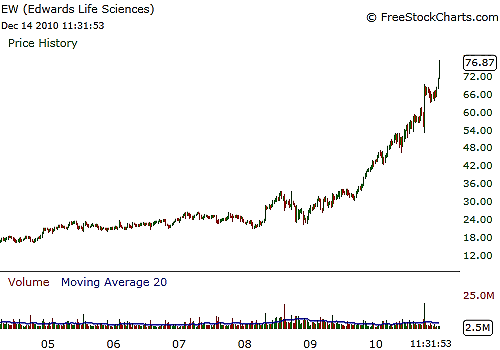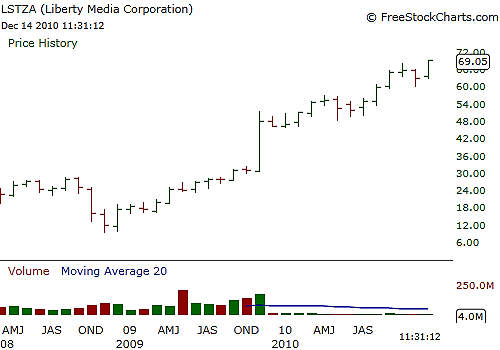
HOT TOPICS LIST
- MACD
- Fibonacci
- RSI
- Gann
- ADXR
- Stochastics
- Volume
- Triangles
- Futures
- Cycles
- Volatility
- ZIGZAG
- MESA
- Retracement
- Aroon
INDICATORS LIST
LIST OF TOPICS
PRINT THIS ARTICLE
by Billy Williams
Part-time traders often become frustrated when they're unable to watch the market all day, but weekly charts give them an advantage of full-time trading.
Position: Hold
Billy Williams
Billy Williams has been trading the markets for 27 years, specializing in momentum trading with stocks and options.
PRINT THIS ARTICLE
TECHNICAL ANALYSIS
Using Weekly Charts To Catch Runaway Moves
12/16/10 12:55:50 PMby Billy Williams
Part-time traders often become frustrated when they're unable to watch the market all day, but weekly charts give them an advantage of full-time trading.
Position: Hold
| Skilled traders who watch the markets full time often have the challenge of fighting boredom or restlessness as trading volume thins out, resulting in markets trading within contracted price ranges or trending slowly in a given direction. Often, traders look for activities to occupy themselves during these periods by writing, golfing, or exercising in order to avoid falling into the trap of trading just to be trading rather than picking their shots when the time is right. The challenge for part-time traders is something altogether different as aspiring traders who seek higher returns are faced with the challenge of watching the market while working full time at a job that is often non-trading related. The challenge for part-timers is that they are often at a desk fielding phone calls or on a construction site swinging a hammer when the markets are open and they are unable to watch for low-risk opportunities when they present themselves. This is a segment of the trading community that is neglected, leaving this group of aspiring speculators feeling as though they are missing out or, worse, that they will never be able to build up their portfolios or get enough experience trading to pick the right trades, enter effectively, manage the position profitably, and cash out at the appropriate time. |

|
| FIGURE 1: EW. A scan of the weekly chart reveals that EW quickly accelerated 50% in value in early 2009 before trading to all-time highs in price and rapidly gaining over 40 points. |
| Graphic provided by: www.freestockcharts.com. |
| |
| If beginning traders are willing to own up to the reality of their particular station, that they are unable to watch the market full time, then they must also tailor their particular approaches and readjust their desired objectives. First, since they can't watch the markets all day, they must have an approach that will allow them to enter a trade without being dependent on staring at the computer screen all day. In fact, many full-time traders will admit that this can be an advantage since active traders often get restless during slow moments in the market's price action and are severely tempted to get into a position to make something happen. This is a fallacy of thinking and can result in poor returns or, even worse, a busted trading account, leaving the trader without enough capital to trade effectively anymore. |

|
| FIGURE 2: LSTZA. Going up a time period to monthly charts, LSTZA bottomed in 2008, shooting up more than 50% before breaking out its all-time high and gaining 40 points for an almost 100% return. |
| Graphic provided by: www.freestockcharts.com. |
| |
| In order to adjust, you must consider watching a longer time frame, an approach that uses only end-of-day data where you can come home, relax, eat, and spend 20 minutes or so scanning for compelling price action in a select list of stocks that have had a rapid increase in share value in a short time frame. Momentum stocks have a tendency to reveal when they are being accumulated by major institutions: when they quickly appreciate in stock price as much as 50% or more within a six- to eight-week period. Watch for stocks that fit this profile and then look to enter after the price action trades up through their all-time high. See Figures 1 and 2. |
| Often, stocks that fit this profile have a tendency to make 50% to 100% returns or more annually and can help build up both your trading experience and your trade capital, giving you an edge without having to watch the market like a hungry hawk till a trade presents itself or suffer the temptation of manic buying or selling just for its own sake. The second thing you should adjust is your desired objectives. Most newcomers to trading have dreams of being the next George Soros, making millions out of the gate. Reality reflects something quite different as most traders lose money versus making it and it is probably a result of this type of false thinking in their approach to the market. You must first build skill, and taking a similar approach like the one outlined will help you do that especially for a beginner. Learn to love the process of scanning the markets, selecting trades, and then managing that position. As your skill grows, money and high returns will be the natural by-product. |
Billy Williams has been trading the markets for 27 years, specializing in momentum trading with stocks and options.
| Company: | StockOptionSystem.com |
| E-mail address: | stockoptionsystem.com@gmail.com |
Traders' Resource Links | |
| StockOptionSystem.com has not added any product or service information to TRADERS' RESOURCE. | |
Click here for more information about our publications!
PRINT THIS ARTICLE

|

Request Information From Our Sponsors
- StockCharts.com, Inc.
- Candle Patterns
- Candlestick Charting Explained
- Intermarket Technical Analysis
- John Murphy on Chart Analysis
- John Murphy's Chart Pattern Recognition
- John Murphy's Market Message
- MurphyExplainsMarketAnalysis-Intermarket Analysis
- MurphyExplainsMarketAnalysis-Visual Analysis
- StockCharts.com
- Technical Analysis of the Financial Markets
- The Visual Investor
- VectorVest, Inc.
- Executive Premier Workshop
- One-Day Options Course
- OptionsPro
- Retirement Income Workshop
- Sure-Fire Trading Systems (VectorVest, Inc.)
- Trading as a Business Workshop
- VectorVest 7 EOD
- VectorVest 7 RealTime/IntraDay
- VectorVest AutoTester
- VectorVest Educational Services
- VectorVest OnLine
- VectorVest Options Analyzer
- VectorVest ProGraphics v6.0
- VectorVest ProTrader 7
- VectorVest RealTime Derby Tool
- VectorVest Simulator
- VectorVest Variator
- VectorVest Watchdog
